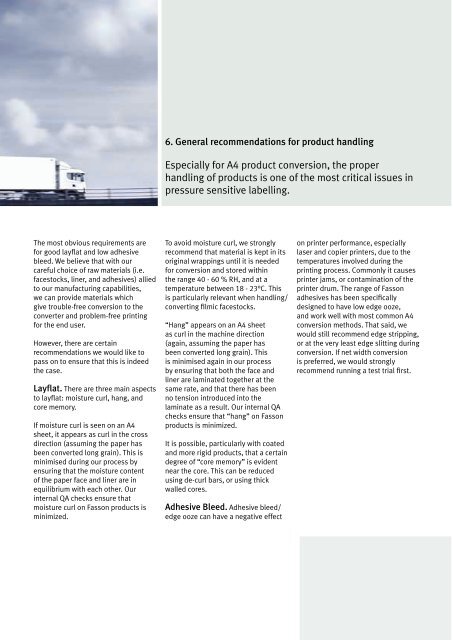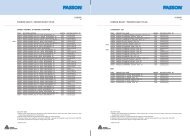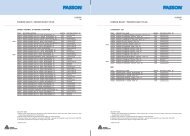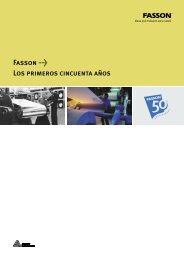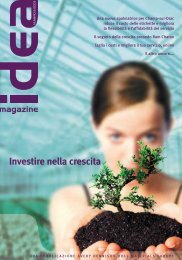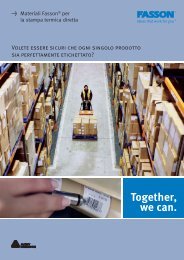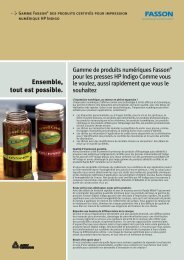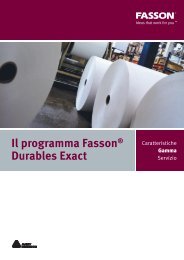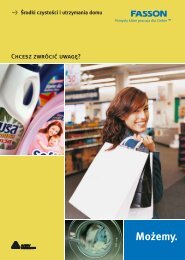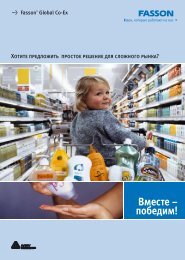open your EYES to MORE labelling SOLUTIONS - Avery Dennison ...
open your EYES to MORE labelling SOLUTIONS - Avery Dennison ...
open your EYES to MORE labelling SOLUTIONS - Avery Dennison ...
You also want an ePaper? Increase the reach of your titles
YUMPU automatically turns print PDFs into web optimized ePapers that Google loves.
The most obvious requirements are<br />
for good layfl at and low adhesive<br />
bleed. We believe that with our<br />
careful choice of raw materials (i.e.<br />
faces<strong>to</strong>cks, liner, and adhesives) allied<br />
<strong>to</strong> our manufacturing capabilities,<br />
we can provide materials which<br />
give trouble-free conversion <strong>to</strong> the<br />
converter and problem-free printing<br />
for the end user.<br />
However, there are certain<br />
recommendations we would like <strong>to</strong><br />
pass on <strong>to</strong> ensure that this is indeed<br />
the case.<br />
Layfl at. There are three main aspects<br />
<strong>to</strong> layfl at: moisture curl, hang, and<br />
core memory.<br />
If moisture curl is seen on an A4<br />
sheet, it appears as curl in the cross<br />
direction (assuming the paper has<br />
been converted long grain). This is<br />
minimised during our process by<br />
ensuring that the moisture content<br />
of the paper face and liner are in<br />
equilibrium with each other. Our<br />
internal QA checks ensure that<br />
moisture curl on Fasson products is<br />
minimized.<br />
6. General recommendations for product handling<br />
Especially for A4 product conversion, the proper<br />
handling of products is one of the most critical issues in<br />
pressure sensitive <strong>labelling</strong>.<br />
To avoid moisture curl, we strongly<br />
recommend that material is kept in its<br />
original wrappings until it is needed<br />
for conversion and s<strong>to</strong>red within<br />
the range 40 - 60 % RH, and at a<br />
temperature between 18 - 23°C. This<br />
is particularly relevant when handling/<br />
converting fi lmic faces<strong>to</strong>cks.<br />
“Hang” appears on an A4 sheet<br />
as curl in the machine direction<br />
(again, assuming the paper has<br />
been converted long grain). This<br />
is minimised again in our process<br />
by ensuring that both the face and<br />
liner are laminated <strong>to</strong>gether at the<br />
same rate, and that there has been<br />
no tension introduced in<strong>to</strong> the<br />
laminate as a result. Our internal QA<br />
checks ensure that “hang” on Fasson<br />
products is minimized.<br />
It is possible, particularly with coated<br />
and more rigid products, that a certain<br />
degree of “core memory” is evident<br />
near the core. This can be reduced<br />
using de-curl bars, or using thick<br />
walled cores.<br />
Adhesive Bleed. Adhesive bleed/<br />
edge ooze can have a negative effect<br />
on printer performance, especially<br />
laser and copier printers, due <strong>to</strong> the<br />
temperatures involved during the<br />
printing process. Commonly it causes<br />
printer jams, or contamination of the<br />
printer drum. The range of Fasson<br />
adhesives has been specifi cally<br />
designed <strong>to</strong> have low edge ooze,<br />
and work well with most common A4<br />
conversion methods. That said, we<br />
would still recommend edge stripping,<br />
or at the very least edge slitting during<br />
conversion. If net width conversion<br />
is preferred, we would strongly<br />
recommend running a test trial fi rst.


